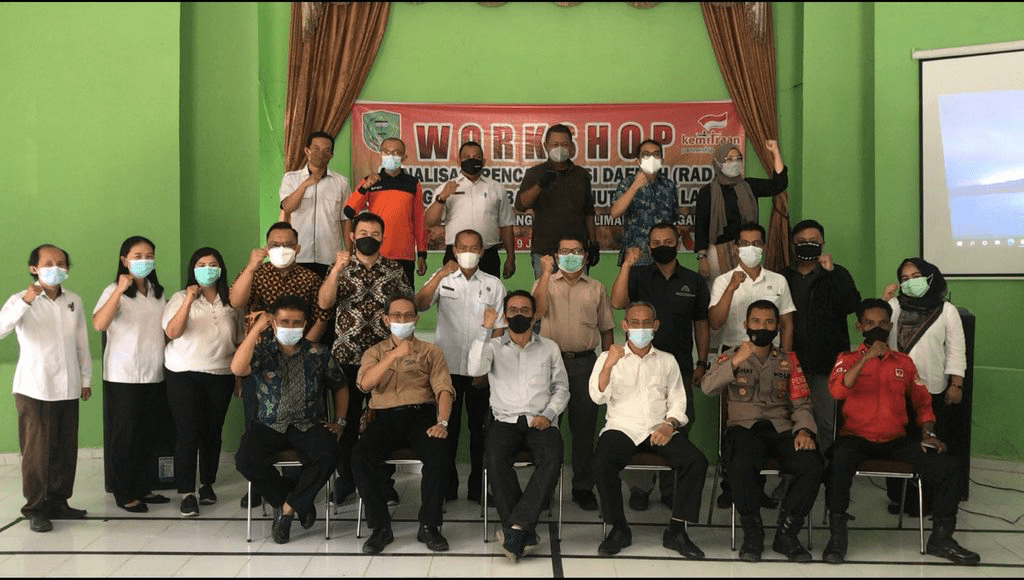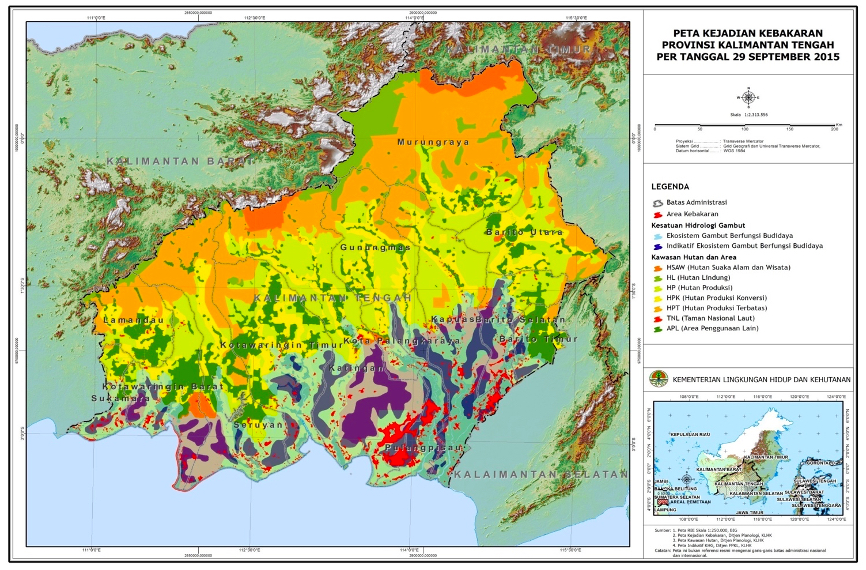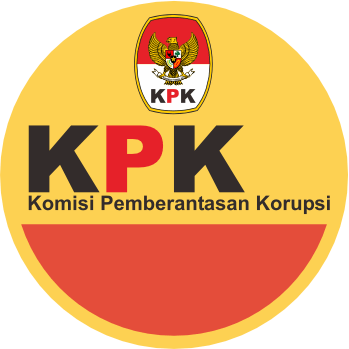

Writer: Andi Kiky (Deputy Cluster SIAP-IFM Pulang Pisau)
Still attached to the author’s memory is the Forest and Land Fires incident in 2015 and then in Kab. Pulang Pisau, Central Kalimantan Province. At that time, it was in the spotlight of the central and provincial governments and included in the national disaster category with a total burned area of approximately 83,965.5 hectares.
Maps and Tables. September 2015 Forest and Land Fires Incident – Ministry of Environment and Forestry

.png)
Most of the land burned in Pulang Pisau is peat. This is reasonable considering that 59.40% or 575,808 hectares of Pulang Pisau Regency or 899,700 hectares are peatlands. Fires on peatlands cause many things, including fires that are more difficult to extinguish, the production of thicker smoke than fires on non-peatlands, and the loss of biodiversity, which is the wealth of peat ecosystems.
Four years later, the Karhutla disaster happened and received the public spotlight again and again. From July to December 2019, 584 hotspots burned approximately 10,000 hectares. Of the total number of hotspots, it is undeniable that some of them were contributed by the alleged occurrence of forest and land fires at the location of large oil palm plantation companies, in addition to allegations that community groups/farmers burned land for cultivation/gardening purposes. The alleged involvement of large oil palm plantation companies from 17 company units in Central Kalimantan, 3 of which are in Pulang Pisau, namely GIJ, MKM and BEST. Although the alleged occurrence of forest and land fires in their area due to “negligence” varies widely, ranging from 10 – 30 hectares.
.png)
In 2020, there was a drastic decrease in the number of hotspots in the Pulang Pisau Regency. The reasons for this are, among others, the high intensity of rain, as well as the very intensive socialisation of the prohibition of forest and land burning [AN3] carried out by BPBD and police officers to land-based farming communities. The ban on burning is prioritised on peatlands as stated in Regional Regulation (PERDA) No. 1/2020 concerning Land Fire Control in Central Kalimantan Province.
On the other hand, the decline in the rate of forest and land fires in 2020 does not eliminate fears of a forest and land fire disaster in the Pulang Pisau Regency. This is by the results of a study by the district BPBD (Regional Disaster Management Agency), which states that the level of risk of forest and land fires is very high in each of the existing sub-districts.
.png)
Seeing the high risk of fire, the KEMITRAAN or Partnership institution invites cooperation with the Pulang Pisau District Government for sustainable peatland management from the forest and forest fires disaster through a cluster approach or Strengthening Indonesia Capacity for Anticipatory Peat Fire Management (SIAP-IFM). The Pulang Pisau government-appointed BPBD (Regional Disaster Management Agency) is the leading sector for program implementation. After that, together with KEMITRAAN rushed to gather the parties to prepare the Karhutla prevention program in line with the arrival of the dry season.
On April 29, 2021, the first meeting between KEMITRAAN, BPBD and representatives of parties, such as DPMD, DLH, Agriculture Service, Food Security Service, PUPR, Bappeda, Manggala Agni, KPHP Kahayan Hilir, and a private company in the district, namely PT. Menteng Kencana Mas and PT. Best Group International.
This first meeting aims to encourage and build a shared understanding regarding the SIAP-IFM program approach that puts forward a cluster approach with three main activities; strengthening policies, strengthening institutions and strengthening capacities. In its implementation, the program requires a collective role from the parties and the legality of regional policies as part of the jurisdiction in prevention efforts.
The meeting suggested the need for a planning document to prevent forest and land fires in Pulang Pisau Regency, and it was discussed at follow-up meetings. Finally, at the intersection of the parties in June, the push for preparing the RAD (Regional Action Plan) document for controlling forest and land fires strengthened.
However, in preparing the RAD, there are obstacles, one of which is convincing the private sector to be actively involved and contribute to efforts to prevent forest and land fires through the term control. According to them, what could be the benefits for them to be involved in controlling forest and land fires? This question becomes commonplace because they also put the budget in their commitment to controlling forest and land fires.
.png)
In mid-July 2021, the author, together with the Regional Secretary and Assistant III for Government of the Regional Secretariat of the Pulang Pisau Regency Government, was able to convince the importance of the company to support and be involved in making a commitment contribution and role in the RAD for Controlling Karhutla.[AN5] Efforts to convince the company can contribute to prevention of forest and land fires, among others reflecting on forest and land fire incidents in previous years, where they were also involved in cases of alleged “negligence” that caused forest and land fires in and around their company areas. Thus, by putting common interests, the company does not stand alone but is supported by the government and other related elements.
On the other hand, the company also considers that an active role through contributions and collectivity in preventing forest and land fires can positively impact the assessment of seriousness. They can publish this as added value in their product market in the country and abroad. The process of convincing the company ultimately led to success. On July 6, 2021, the Regional Secretary and Assistant III facilitated a meeting with the company PT. Menteng Kencana Mas and PT. Best Group International agreed to contribute to the RAD for Combating Karhutla in Pulang Pisau. The real contribution of the company in question is not much different from what they have given during the period from 2015 to 2020. These include support for Karhutla patrols within and around the company’s area, assistance in the procurement of the Dalkarhutla Sarpras, capacity building in controlling/handling forest and land fires for community groups, simulations Dalkarhutla and as contained in the RAD.
While the OPD (Regional Apparatus Organizations) are related to the adjustment of programs and activities that are closely related to the prevention of forest and land fires, such as increasing the capacity of farmers through training on land management without burning (PLTB), socialisation of the dangers of forest and land fires to community groups/farmers/business institutions and students, support for Sarpras Dalkarhutla and many more by including various budget items and referring to the 2019-2023 RPJMD.
On August 12, 2021, the RAD document for controlling forest and land fires was approved by the Regional Secretary of Pulang Pisau and became the first document in Central Kalimantan Province and possibly in Indonesia that puts forward a prevention approach in handling forest and land fires. The RAD document contains 12 institutions/organisations/agencies that will be involved in the program and 50 activity units with a total budget value of Rp. 12,683,054,960,-.
At the time of ratification, the Regional Secretary [AN8] Mr Tony Harisinta, SE. M.Si conveyed three main messages related to the program;
1) Handling forest and land fires does not only rely on one party but becomes part of shared responsibility;
2) The RAD document is part of learning the contribution of the parties as a manifestation of commitment in handling the forest and land fires disaster; and
3) The RAD document can also be used as a reference for preparation in the following year so that the occurrence of forest and forest fires can be prevented or anticipated earlier with the roles and contributions of the parties.
This means that the approach to prevent forest and land fires in the cluster provides lessons that “Talking about any disaster is part of a shared responsibility and is accompanied by a commitment that can be measured, evaluated and accounted for governance in disaster management,” said Tony Harisinta, SE. M.Si.





